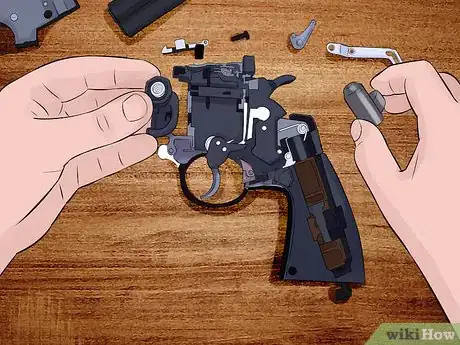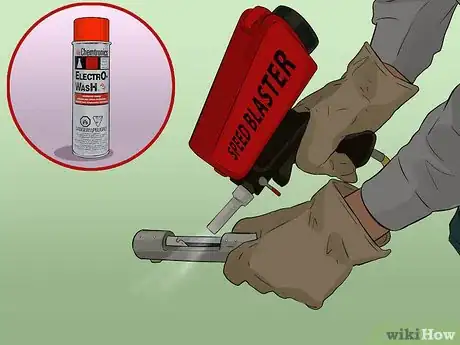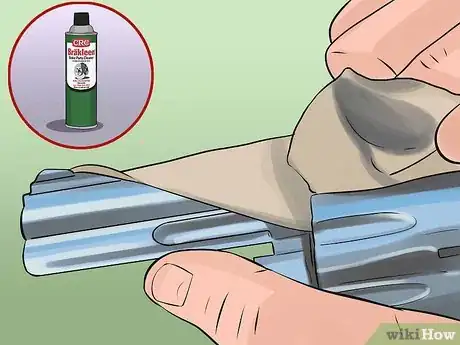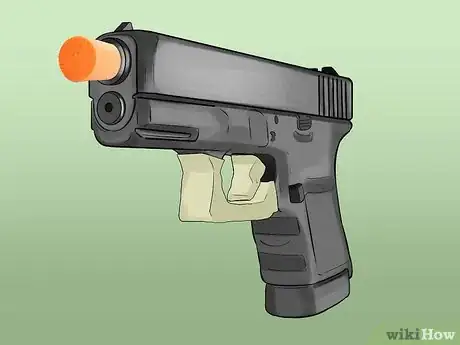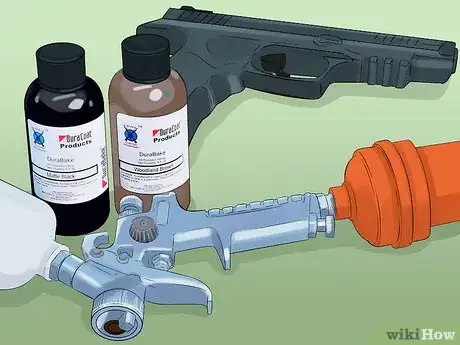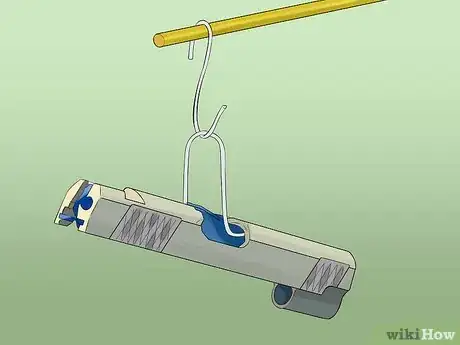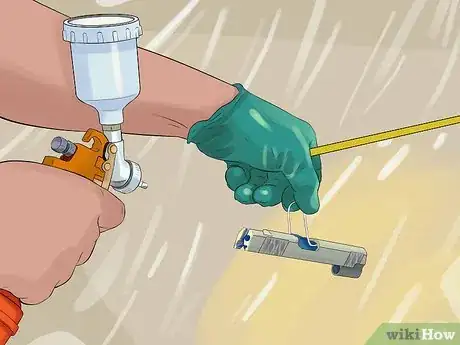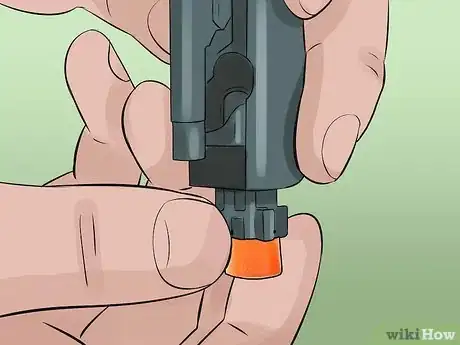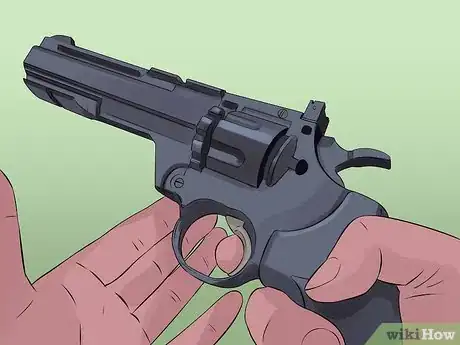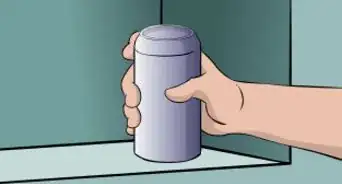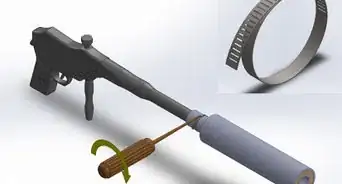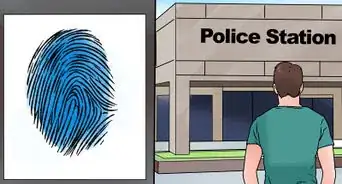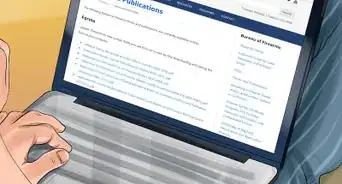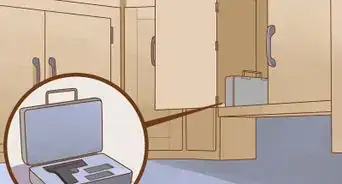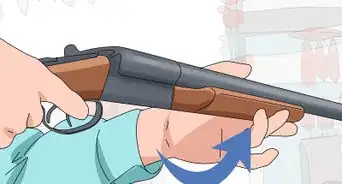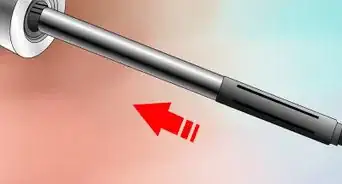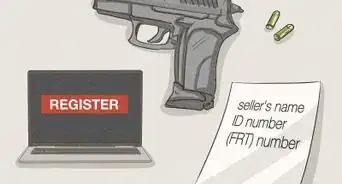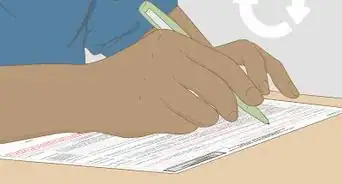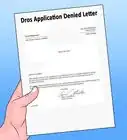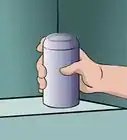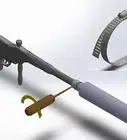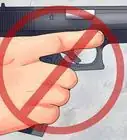This article was co-authored by wikiHow staff writer, Sophia Latorre. Sophia Latorre is a Content Manager on the wikiHow team. Before joining wikiHow, Sophia worked as a technical editor and was published in six International Energy Agency (IEA) Wind Annual Reports. Now, she writes, edits, and reviews articles for the wikiHow Content Team, working to make the content as helpful as possible for readers worldwide. Sophia holds a BA in English from Colorado State University.
This article has been viewed 81,310 times.
Learn more...
You can easily change the color of any rifle or pistol by painting it in it’s entirety or painting individual pieces. However, it’s important that you have thorough knowledge of the gun first, as you may need to disassemble and reassemble it to complete this project. Be sure to follow all rules and regulations concerning gun ownership and operation in your area, and never paint a fake gun to make it look real.[1]
Steps
Prepping the Gun
-
1Disassemble the gun if you only want to paint certain parts. The procedure for disassembling a gun varies by model. If you haven’t done this before, follow the instructions provided in the manual or watch instructional videos online. Take pictures throughout the process so that you can refer to them when reassembling the gun.[2]
-
2Sand the parts you want to paint. The best way to sand the parts is to use a sandblaster to remove the existing paint or coating from the metal. Use 120-grit aluminum oxide blasting media. If you can’t access a sandblaster, rough up the surface of the existing paint with sandpaper. This process preps the pieces so the new paint will adhere evenly.[3]
- You can rent a sandblaster from your local home improvement store.
Advertisement -
3Clean metal parts with an aerosol degreasing agent. You need an aerosol degreasing agent that dries without residue, like Brakleen or TruStrip Solvent. Put on gloves, a long-sleeved shirt, and eye protection, such as a face shield. Be sure you are working in a well-ventilated area. Spray each metal part with the degreasing agent and wipe it down with a clean, lint-free cloth.[4]
- Clean plastic pieces with 91% isopropyl alcohol instead of the aerosol degreasing agent.[5]
- Use clean gloves to handle the clean parts as oils from your fingers will mar the surface and prevent the paint from adhering properly.
-
4Mask any areas you don’t want coated and plug all holes. Use masking tape to cover all moving parts as well as any areas that you don’t want painted, like the trigger and trigger guard. Use modeling clay or foam ear plugs to plug holes in parts like the barrel so paint won’t pool inside them.[6]
Changing the Color
-
1Choose metal paint designed for use on guns. Some products, like DuraCoat, air dry to a set finish. Other products, like DuraBake, need to be baked to set the finish. You can bake small metal parts in a toaster oven. However, if you plan to keep the gun intact or if the parts are too large to fit in the toaster oven, be sure to choose paint that sets while air drying and doesn’t need to be baked.[7]
-
2Suspend the parts or gun in the air. Use wire, like a coat hanger, to hang the parts or gun so you can access them from 360 degrees. Put a plastic dropcloth over your work area and wear a respirator, safety glasses, and gloves.[8]
-
3Spray the parts with the desired paint. You can buy finishing kits that come with aerosol spray cans, or use a paint sprayer powered by compressed air. Hold the can or sprayer 6 to 8 inches (15 to 20 cm) away from the surface and spray each part or the whole gun with smooth, back-and-forth motions until all areas are evenly covered. Let the paint dry, then apply a second coat, if desired.[9]
- Use sponges dipped in paint to dab on different colors if you want to camouflage the gun.
-
4Remove the tape and clay or plugs once the paint has air dried. Refer to the instructions on the paint to find out how long it takes to dry. Generally, paint will be dry to the touch in 30 minutes to 2 hours. Carefully remove the masking tape and any modeling clay or foam ear plugs from the holes.[10]
-
5Bake metal parts if required. This should only be done to parts that have been disassembled from the gun, rather than an intact weapon. You can use a toaster oven to bake the metal pieces if the paint requires it. Use wire to suspend the parts from the top of the oven, then bake them for 30 minutes at 350 °F (177 °C), or as the instructions dictate.[11]
- Use an oven-safe thermometer to ensure the toaster oven is operating at the correct temperature.
-
6Reassemble the gun, if necessary. If you haven’t done this before, it can be helpful to refer to an exploded-view illustration of the gun, which can be found in the manual or online. You can also refer to the pictures you took when disassembling the gun, or watch online instructional videos to help you put all the parts back together correctly.[12]
Things You’ll Need
- Camera
- Gun manual or instructional videos for disassembly and reassembly
- Gloves, several pairs
- Long-sleeved shirt
- Eye protection (safety glasses or face shield)
- Aerosol degreasing agent (like Brakleen or TruStrip Solvent)
- 91% isopropyl alcohol
- Clean, lint-free cloth
- Sandblaster and 120-grit aluminum oxide blasting media OR sandpaper
- Masking tape
- Modeling clay or foam earplugs
- Plastic dropcloth
- Respirator
- Metal paint designed for guns
- Aerosol spray can or paint sprayer powered by compressed air
- Wire
- Toaster oven
- Oven-safe thermometer
References
- ↑ http://edition.cnn.com/2003/LAW/01/08/ctv.toy.guns/
- ↑ http://www.range365.com/paint-your-pistol
- ↑ http://www.range365.com/paint-your-pistol
- ↑ http://www.range365.com/paint-your-pistol
- ↑ https://www.youtube.com/watch?v=DNr33MFflAQ&feature=youtu.be&t=104
- ↑ http://www.popularmechanics.com/military/weapons/a5764/how-to-camouflage-a-rifle/
- ↑ http://www.range365.com/paint-your-pistol
- ↑ http://goneoutdoors.com/paint-gun-5143363.html
- ↑ http://www.popularmechanics.com/military/weapons/a5764/how-to-camouflage-a-rifle/
About This Article
You can give your gun a new lick of paint at home with a few simple tools. You can either disassemble your gun and paint individual parts or paint the whole thing. Before you paint it, sand your gun down with a sandblaster or sandpaper to help the paint stick, and spray it with an aerosol degreasing agent to clean it. Cover any parts you don’t want painted with masking tape. Then, hang your gun or gun parts from a coat hanger or other wire so you can easily paint each side. Use spray paint designed for guns. Some paints will need to be baked afterwards, but if you want to keep your gun intact or if the parts are too large to fit in your toaster oven, choose paint that sets while air drying. For more tips, including how to plug holes in your gun to protect them from paint, read on!
